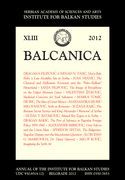The Classical and Hellenistic Economy and the “Paleo-Balkan” Hinterland: A Case Study of the Iron Age “Hellenized Settlements”
The Classical and Hellenistic Economy and the “Paleo-Balkan” Hinterland: A Case Study of the Iron Age “Hellenized Settlements”
Author(s): Ivan VranićSubject(s): Archaeology
Published by: Balkanološki institut - Srpska akademija nauka i umetnosti
Keywords: “Hellenized settlements”; “Hellenization” and the Balkan Iron Age hin-terland; economic anthropology; Classical and Hellenistic economy; status identity; Kale-Krševica
Summary/Abstract: Dozens of similar fortified settlements exhibiting a familiarity with some Greek building techniques and traditions existed in some parts of the Balkans dur-ing the Iron Age, especially from the fifth to third century BC. The settlements are documented in a vast continental area stretching from modern-day Albania, the FYR Macedonia and south central Serbia to Bulgaria. Archaeological interpretations mostly accept that economic factors and trade with late Classical and early Hellenis-tic Greece were instrumental in their emergence, and the phenomenon is interpreted as Greek “influence” and local “imitation” of Mediterranean culture. Presenting the most influential interpretations of the Classical and Hellenistic economy and some perspectives in economic anthropology, this paper examines the traditional (mostly formalistic) culture-historical understanding of the Balkan “Hellenized settlements” of the mid-first millennium BC and Mediterranean interrelations. It also looks at the construction and role of status identity as a crucial social factor in shaping the Iron Age communities in the hinterland, and defines possible trade and exchange activities as only one aspect of the identity of a burgeoning elite.
Journal: BALCANICA
- Issue Year: 2012
- Issue No: 43
- Page Range: 29-50
- Page Count: 22
- Language: English

